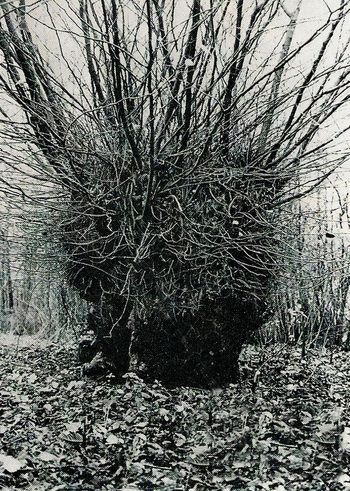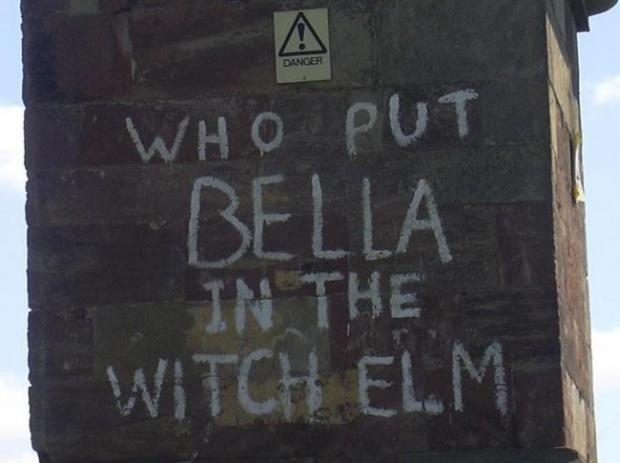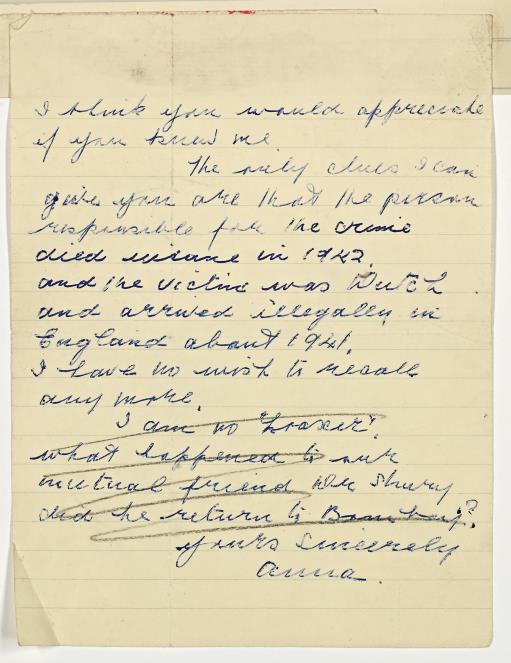‘Who Put Bella in the Wych Elm?’: Espionage, Witchcraft, and other Theories

On 18 April 1943 four boys made a grisly discovery in Hagley Wood in Worcestershire, England on a stretch of private residential property. While bird-nesting in the area, they came upon a large wych elm tree and one of the boys, Bob Farmer, climbed in the hopes of finding a bird nest. Instead, Farmer discovered a human skull complete with remnants of curly brown hair inside the tree’s hollow trunk. Farmer and the other boys weighed their options – admit they were trespassing when they made the discovery, or leave the skull in the tree and pretend it never happened. They agreed on the latter and went home with the intention of taking their knowledge of the skull (and their trespassing) to the grave.
Thankfully the youngest boy, Thomas Willetts, confessed the group’s findings to his parents that night. Unknown to the boys, their discovery would spark a decades long hunt for the identity of the women that came to be known as ‘Bella’ and a murder that remains unsolved to this day.
The Crime Scene

When police arrived at the scene they discovered more than just a human skull. Stuffed in the hollow of the wych elm was the nearly complete skeleton of an adult woman. There were some fragments of clothing on her remains including a shoe and a gold wedding ring. Curiously, one of her hands had been separated from the rest of her body and was located nearby (more on that later). Along with her body, the woman’s skull was valuable evidence as it contained her very distinctive dental pattern.
After a forensic examination it was determined by pathologist Professor James Webster that the woman’s corpse was placed within the tree while it was ‘still warm’ around 18 months prior to the discovery. Webster believed that, based on the width of the tree’s hollow trunk her body wouldn’t have been able to fit if she was post-rigor mortis. The cause of death was determined to be suffocation from a piece of taffeta that had be lodged deep in her mouth.
Because of the woman’s distinctive teeth, police contacted every dentist in the country in an effort to identify the victim. Simultaneously, they ran a check of missing persons cases in the hopes of finding a potential match. However, both search efforts were done in vain.
“Who put Bella in the wych elm?”

On 24 April 1943 the Hartlepool Northern Daily Mail published a hypothesised description of the woman’s appearance prior to her death. The description read:
Her age is given as between 25 and 40, most probably 35, height 5ft, with light brown hair and dressed in dark blue and mustard coloured striped cardigan and mustard coloured skirt: blue crepe soled shoes, size 5 ½ . All the garments were described as poor quality, and a wedding ring found among the bones was of rolled gold, probably worth 2/6 to-day.
Hartlepool Northern Daily Mail, 24 April 1943 (source)
Admittedly, this wasn’t a whole lot of information to go off of. Hundreds of leads were generated but the true identity of the woman remained unknown. The case was left in a state of limbo until 1944 when two pieces of mysteries graffiti were discovered. The first read ‘Who put Luebella down the wych elm?‘ and was found at Hayden Hill Road, Old Hill and the second read ‘Who put Bella down the Wych elm, Hagley Wood?‘ on a wall on Upper Dean Street, Birmingham.
This strange addition to an already strange case produced more questions than answers. At this point, the woman had not been assigned any sort of name, so the graffiti in both Old Hill and Birmingham mentioning a woman named ‘Bella’, or ‘Luebella’, implied that someone may know the identity of the woman in the wych elm. But who?
On 30 March 1944 the Evening Despatch wrote the following about the mysterious graffiti artist:
…the writing was too high on the wall to have been done by boys, and the police are inclined to the view that it is the work of someone coming into the city early in the morning with farm produce.
Evening Despatch, 30 March 1944 (source)
Were the police to consider the unknown graffiti artist (or artists) as someone ‘in the know’? Or was the graffiti simply a bizarre hoax? And, most importantly, was the dead woman’s name actually Bella? Unfortunately, no new leads came from the graffiti in Old Hill and Birmingham, but it could be argued that the catchy phrase and it’s mysterious origin have kept the mystery of Bella in the Wych Elm alive and well many decades later.

Since the 1970s, the phrase ‘who put Bella in the witch Elm‘ has been sporadically written on the Wychbury Obelisk near the summit of Wychbury Hill in Hagley, Worcestershire. The current rendition of the graffiti on the obelisk was sprayed at some point during the 1990s. The graffiti, which has become a staple of local folklore, was itself vandalised in 2020. The vandalism changed the word ‘who‘ to ‘hers‘, altering the phrase to ‘HERS put Bella in the Witch Elm‘. The Stourbridge News wrote that the suspected culprit was likely a Birmingham graffiti artist known as Hers (hence the alteration of the original graffiti).
While iconic, the original two instances of graffiti didn’t lead the police to any new suspects. It was clear that whoever killed Bella was keen to keep their identity and the identity of their victim unknown.
Theories
While the case of Bella’s identity is still a mystery, there have been various theories put forward throughout the years. Unfortunately, most theories are dead ends or were so over-the-top that they were never actually taken seriously. Regardless, the following five theories are the leaders within the ongoing conversation attempting to finally solve the case of Bella in the Wych Elm.
1. Bella was German Singer and Actress Hedwig Clara Bäuerle

On 1 February 1941 during the second World War Josef Jacobs parachuted into a Cambridgeshire field, suffering a broken ankle on impact. He was discovered by local farmers who promptly contacted the police. Suspecting Jacobs was a spy, the case was passed over to the MI5. Among his belongings was a photograph of a woman later identified as German singer and actress Clara Bäuerle. According to Jakobs (though he wasn’t considered a reliable source), Bäuerle was a secret agent who had parachuted into the Midlands around the same time or shortly after Josef. It’s also said that he identified her as his lover, though it doesn’t appear to be true.
Another version of the story says that Clara was already in the West Midlands performing in music halls and learning to hide her German accent. It was there that she was recruited by the Gestapo (official secret police of Nazi Germany and German-occupied Europe). Allegedly, Josef Jacobs and Clara Bäuerle never actually made contact.
Details on how Clara would have ended up dead in the wych elm isn’t a typical part of the Clara Bäuerle portion of the Bella in the Wych elm folklore. The connection between Bella and Clara would have come from a disappearance of Clara from any films or recording after 1941 (the hypothesised time of Bella’s death) and the photograph found on Jacobs.
However, this theory was put to rest once Bäuerle’s official death registration was located. Her cause of death was listed as a lung infection due to Veronal poisoning on 16 December 1942 in Berlin, putting her time of death about a year later than the one assigned to Bella. As Veronal was a popular sleeping aid during the early 1900s, it’s unspecified if Bäuerle’s death was an accidental overdose, suicide, or murder. There’s also the question of whether or not we should trust German Nazi-era death records. Another mystery for another day.
‘Fun’ fact: Josef Jakobs, convicted of espionage under the Treachery Act 1940, was executed at the Tower of London on 15 August 1941 by firing squad. He was the last person to ever be executed at the Tower of London.
(Some recordings of Bäuerle are available on YouTube if you search ‘Claire Bäuerle’. Here’s Bäuerle singing in a performance from 1939, three years before her death.)
2. Bella was an Unknown Sex Worker or Refugee

In 1944, a local sex worker contacted the Birmingham police to report the disappearance of another sex worker named Luebella who had vanished three years prior. It was thought that Luebella had been lured into Hagley Wood where she was murdered by persons unknown.
Another theory, put forth by the police, was that Bella was a refugee from The Blitz. During the Second World War, the Germans launched a bombing campaign from the skies of the United Kingdom with attacks on port and industrial cities including Birmingham. This theory suggests that Bella, while living in Birmingham, hid in Hagley Wood during one of the air raids since this was a known location for people to shelter from attack.
Neither of these theories led police to further evidence.
3. Bella was a Spy
This theory is a bit messy and a lot of points end up contradicting each other, so bear with me.
In 1953 journalist Wilfred Byford-Jones re-visited the still unsolved murder while writing under the pen name ‘Quaestor’ for the Express and Star newspaper. Byford-Jones received numerous letters in response to his article including one from a woman who went by ‘Anna of Claverley’. Her letter began with an ominous message:
Finish your articles re the Wych elm crime by all means. They are interesting to your readers, but you will never solve the mystery. The one person who could give the answer is now beyond the jurisdiction of the earthly courts.
Letter from Anna of Claverley to Wilfred Byford-Jones (aka Quaestor), 1953
Anna then hinted that she knew the identity of Bella’s killer and that the individual died ‘insane’ in 1942. She hinted that ‘Bella’ was Dutch and illegally in England as of 1941. It was clear from her letter that Anna was either privy to the unknown details of the crime or she was making things up for attention. Regardless, the police persuaded her to meet with them in person along with Byford-Jones.
According to Anna (later identified as Una Mossop), her ex-husband (Jack Mossop) worked among a group a pro-German conspirator who had been syphoning information about munitions and aircraft factors in the West Midlands to Germany. She claimed that ‘Bella’ was also a spy operating within the same area and that Anna’s ex-husband was present when Bella’s body was put in the wych elm. She also mentioned another Dutch citizen named Van Ralt in connection with Bella’s murder. Allegedly, Bella was murdered due to her extensive knowledge of the pro-German spy ring and her body was hidden to cover the trail of her killers.
Another version of Anna’s story says that her husband and van Ralt were drinking in a local pub with Bella when she passed out. They put her unconscious body into their car and drove into Hagley Wood where the put her body in a tree to ‘teach her a lesson’. When she woke up she was unable to get out of the tree and died. This version however neglects to mention the piece of taffeta that had been found in Bella’s mouth upon the discovery of her remains.
A third, similar version is that Anna’s ex-husband helped hide Bella’s body after van Ralt killed her after an altercation in a local pub.
According to Anna, her ex-husband was haunted by dreams of a skull in a tree and deeply disturbed by the incident. By the time Bella’s body was located, Jack Mossop had died in St. George’s Hospital in Stafford following a mental breakdown.
Anna’s claims were investigated by both MI5 and the police but no arrests or new developments arose. It’s unclear how seriously her story was taken, especially since she didn’t come forward until 12 years after the body was (very publicly) discovered and her ex-husband had passed away.
4 . Bella was Killed by ‘Gypsies’
There isn’t much to this theory, but it typically circulates alongside the others. Allegedly, locals of the Hagley Wood area claimed that ‘gypsies’ had been camping within the woods during 1941 and murdered Bella. There are also theories that Bella herself was a ‘gypsy’ and was killed by her own people for an unknown reason. There is absolutely nothing to back this theory up and could very well be based in veiled racism, which isn’t unheard of in the United Kingdom, even today.
5. Bella was Targeted by a Coven of Local Witches
Remember how the hand that was found separately from Bella’s skeletal remains? Professor Margaret Alice Murray, a prestigious researcher in folklore and dubbed the ‘Grandmother of Wicca’, put forth a peculiar, supernatural explanation. According to Murray, the removal of Bella’s hand and separation from the body was reminiscent of the creation of a Hand of Glory. A Hand of Glory is an old European belief that involves the removal of a hanged criminal’s hand (the hand that committed the crime) during a lunar eclipse. A description of the proper creation of an authentic Hand of Glory can be found in the Petit Albert, an 18-century Cabalistic grimoire. The description was as follows:

Take the right or left hand of a felon who is hanging from a gibbet beside a highway; wrap it in part of a funeral pall and so wrapped squeeze it well. Then put it into an earthenware vessel with zimat, nitre, salt and long peppers, the whole well powdered. Leave it in this vessel for a fortnight, then take it out and expose it to full sunlight during the dog-days until it becomes quite dry. If the sun is not strong enough put it in an oven with fern and vervain. Next make a kind of candle from the fat of a gibbeted felon, virgin wax, sesame, and ponie, and use the Hand of Glory as a candlestick to hold this candle when lighted, and then those in every place into which you go with this baneful instrument shall remain motionless.
Description written by Émile-Jules Grillot de Givry (1874-1929) based on his reading of the 1722 edition of the Petit Albert (source)
Was Bella targeted for her crimes committed against a local coven? Was her murder and the removal of her hand part of an esoteric ritual? While an entertaining story, this theory is definitely more farfetched than the others.
Surprisingly, the occult theory was initially taken seriously by police. Especially since the body of a local man named Charles Walton in nearby Lower Quinton had been found pinned to the ground with his own pitchfork and with a cross carved into his chest. After Professor Murray proposed a link between the cases of Bella in the wych tree and the bizarre murder of Charles Walton, Scotland Yard began to pursue this as a potential lead. However, in the end the police came to conclusion that the separation of the hand from the corpse was likely due to hungry animals and not a satanic coven. There was also no evidence of a coven operating in the Hagley Wood area at the time of the murder, or prior.
Facial Recognition and a Mystery Still Unsolved

In 2018, speculation around the identity of Bella resurfaced when British anthropologist Caroline Wilkinson created a facial reconstruction of Bella’s physical features based on photographs of her skull. Wilkinson had previously made headlines when she created a facial reconstruction of King Richard III when his remains were uncovered in a Leicester carpark in 2012. The resulting image of Bella (seen above) shows her distinctive front teeth and gives a greater identity to the unknown woman.
Will the facial reconstruction lead towards a real identity for Bella? And will her killer and the reason for her murder ever be uncovered? Over 75 years later and we’re still no closer to the truth, but the sad tale of Bella in the Wych Elm has solidified itself in West Midlands folklore with the story kept alive thanks to the strange graffiti that mysteriously appears periodically around the area.
Sources and Additional Reading
BBC News – UK Murder mystery returns to haunt image
Birmingham Live – Revealed after 75 years: The face of Bella in the Wych Elm
Crime Reads – Who Put Bella in the Wych Elm?
Explore the Past – Monthly Mystery: Who put ‘Bella’ in the wych elm?
Independent – Is this Bella in the wych elm? Unravelling the mystery of the skill found in a tree trunk
Mental Floss – A Digital Reconstruction Reveals the Face of Famed Murder Victim ‘Bella in the Wych Elm’
National Archives – Shot at the Tower
Stourbridge News – Iconic Bella graffiti on Hagley monument mysteriously changed
The British Newspaper Archive – “Who Put Bella Down the Wych Elm?” – An Unsolved Murder Mystery Seventy-Seven Years On (this is an excellent source for this case and highly recommended for anyone wanting to learn more)
The History Press –Who put Bella in the wych elm?
The Whitby Guide – Hand of Glory: The Dark Secret of the Severed Hand at Whitby Museum
Whitby Museum – The Hand of Glory


